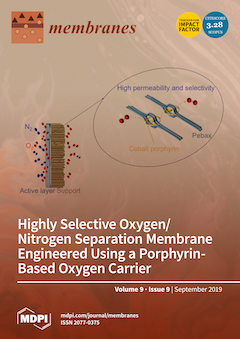In the present study, the separation performance of new self-standing polyvinylamine (PVAm) membranes loaded with few-layer graphene (G) and graphene oxide (GO) was evaluated, in view of their use in carbon capture applications. PVAm, provided by BASF as commercial product named Lupamin
TM
[...] Read more.
In the present study, the separation performance of new self-standing polyvinylamine (PVAm) membranes loaded with few-layer graphene (G) and graphene oxide (GO) was evaluated, in view of their use in carbon capture applications. PVAm, provided by BASF as commercial product named Lupamin
TM, was purified obtaining PVAm films with two degrees of purification: Low Grade (PVAm-LG) and High Grade (PVAm-HG). These two-grade purified PVAm were loaded with 3 wt% of graphene and graphene oxide to improve mechanical stability: indeed, pristine tested materials proved to be brittle when dry, while highly susceptible to swelling in humid conditions. Purification performances were assessed through FTIR-ATR spectroscopy, DSC and TGA analysis, which were carried out to characterize the pristine polymer and its nanocomposites. In addition, the membranes′ fracture surfaces were observed through SEM analysis to evaluate the degree of dispersion. Water sorption and gas permeation tests were performed at 35 °C at different relative humidity (RH), ranging from 50% to 95%. Overall, composite membranes showed improved mechanical stability at high humidity, and higher glass transition temperature (T
g) with respect to neat PVAm. Ideal CO
2/N
2 selectivity up to 80 was measured, paired with a CO
2 permeability of 70 Barrer. The membranes’ increased mechanical stability against swelling, even at high RH, without the need of any crosslinking, represents an interesting result in view of possible further development of new types of facilitated transport composite membranes.
Full article






